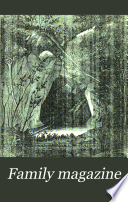 | Jared Sparks, Edward Everett, James Russell Lowell, Henry Cabot Lodge - 1827 - 532 pages
...for himself, as he is said to do in other parts of the world, where no burrowing animals exist. The villages are very numerous, and variable in their...form of a truncated cone, about two feet in width at base, and seldom rising as high as eighteen inches above the surface of the soil. The entrance is placed... | |
 | Jared Sparks, Edward Everett, James Russell Lowell, Henry Cabot Lodge - 1827 - 538 pages
...for himself, as he is said to do in other parts of the world, where no burrowing animals exist. The villages are very numerous, and variable in their...form of a truncated cone, about two feet in width at base, and seldom rising as high as eighteen inches above the surface of the soil. The entrance is placed... | |
 | 1827 - 532 pages
...commodious, as to render it unnecessary that it should dig for itself, as it is said to do in other parts of the world, where no burrowing animals exist. These...for miles together. They are composed of slightly * Turtoo, Lin. vol. i. 169. elevated mounds, about two feet in width at the base, and seldom exceeding... | |
 | James Rennie - 1830 - 442 pages
...for himself, as he is said to do where no burrowing animals exist*. The villages of the prairie-dog are very numerous and variable in their extent, —...the country for miles together. They are composed of slightly-elevated mounds, having the form of a truncated cone, about two feet in width at the base,... | |
 | Alexander Wilson, Charles Lucian Bonaparte - 1831 - 392 pages
...parts of the world, where no burrowing animals Mist, These villages are very numerous, and variable >n their extent, sometimes covering only a few acres,...form of a truncated cone, about two feet in width at base, and seldom rising as high as eighteen inches above the surface of the soil. The entrance is placed... | |
 | Alexander Wilson, Charles Lucian Bonaparte, George Ord, William Maxwell Hetherington - 1831 - 760 pages
...These villages are very numerous, and variable ;" their extent, sometimes covering only a few acres, md at others spreading over the surface of the country...form of a truncated cone, about two feet in width at base, and seldom risinj as high as eighteen inches above the surface of the soil. The entrance is placed... | |
 | 1836 - 496 pages
...as to render it unnecessary that our bird should dig for himself, as he is said to do in other parts of the world, where no burrowing animals exist. These...the country for miles together. They are composed of slightly-elevated mounds, having the form of a truncated cone, about two feet in width at base, and... | |
 | John James Audubon - 1840 - 388 pages
...as to render it unnecessary that our bird should dig for himself, as he is said to do in other parts of the world, where no burrowing animals exist. These...form of a truncated cone, about two feet in width at base, and seldom rising as high as eighteen inches above the surface of the soil. The entrance is placed... | |
 | 1842 - 172 pages
...burrowing animals do not exist. These villages, which are numerous, vary in extent, sometimes covering a few acres, and at others spreading over the surface of the country for miles. They are composed of mounds, about two feet in width at the base, and seldom rising eighteen inches... | |
 | 1843 - 488 pages
...as to render it unnecessary that our bird should dig for himself, as he is said to do in other parts of the world, where no burrowing animals exist. These...the country for miles together. They are composed of slightly-elevated mounds, having the form of a truncated cone, about two feet in width at base, and... | |
| |